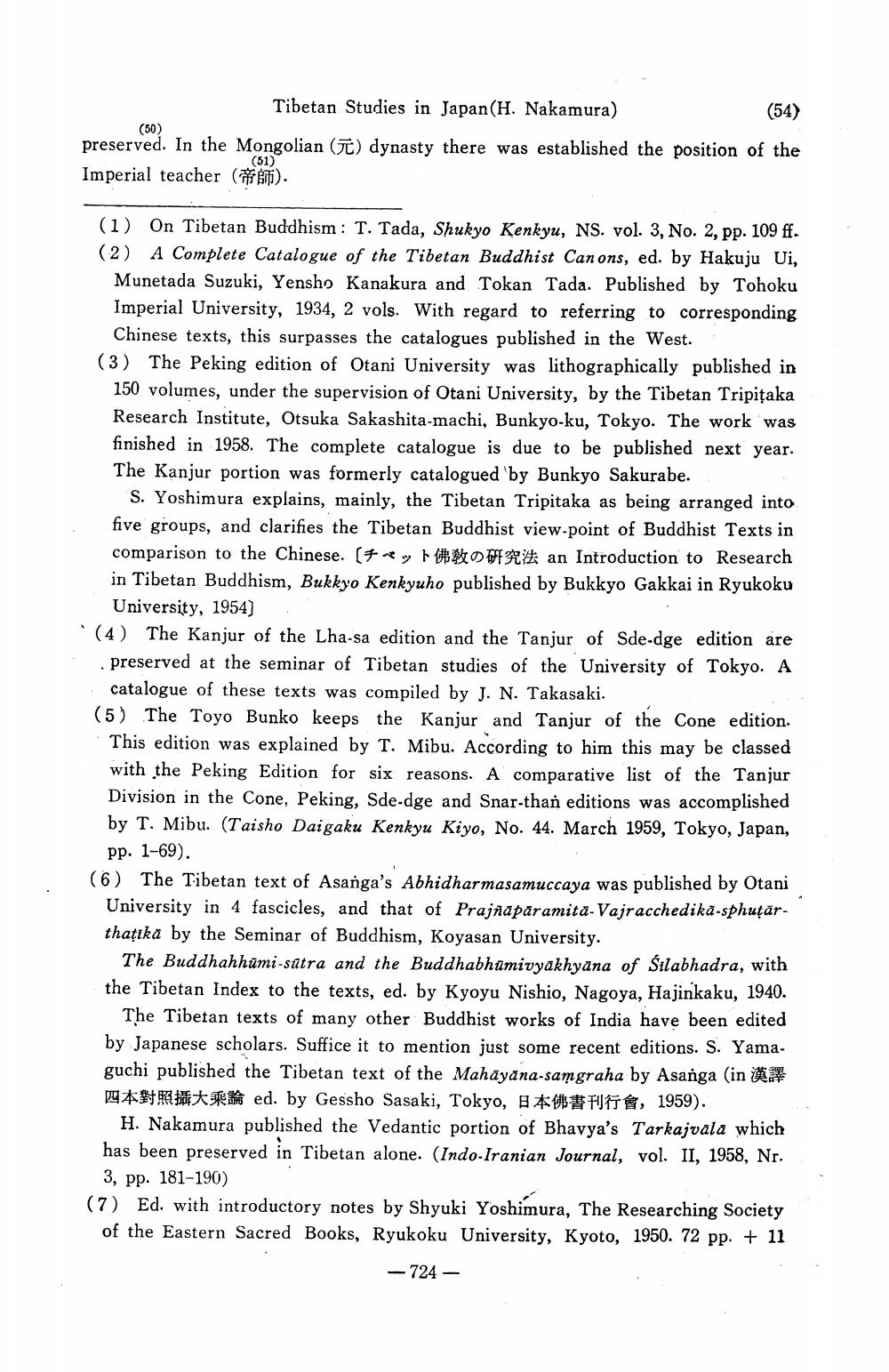Book Title: Tibetan Studies In Jjapan Author(s): Hajime Nakamura Publisher: Hajime Nakamura View full book textPage 9
________________ (50) Tibetan Studies in Japan (H. Nakamura) (54) preserved. In the Mongolian (T) dynasty there was established the position of the Imperial teacher ( ni). (51) (1) On Tibetan Buddhism : T. Tada, Shukyo Kenkyu, NS. vol. 3, No. 2, pp. 109 ff. (2) A Complete Catalogue of the Tibetan Buddhist Canons, ed. by Hakuju Ui, Munetada Suzuki, Yensho Kanakura and Tokan Tada. Published by Tohoku Imperial University, 1934, 2 vols. With regard to referring to corresponding Chinese texts, this surpasses the catalogues published in the West. (3) The Peking edition of Otani University was lithographically published in 150 volumes, under the supervision of Otani University, by the Tibetan Tripitaka Research Institute, Otsuka Sakashita-machi, Bunkyo-ku, Tokyo. The work was finished in 1958. The complete catalogue is due to be published next year. The Kanjur portion was formerly catalogued by Bunkyo Sakurabe. S. Yoshimura explains, mainly, the Tibetan Tripitaka as being arranged into five groups, and clarifies the Tibetan Buddhist view.point of Buddhist Texts in comparison to the Chinese. (チベット佛教の研究法 an Introduction to Research in Tibetan Buddhism, Bukkyo Kenkyuho published by Bukkyo Gakkai in Ryukoku University, 1954) (4) The Kanjur of the Lha-sa edition and the Tanjur of Sde-dge edition are preserved at the seminar of Tibetan studies of the University of Tokyo. A catalogue of these texts was compiled by J. N. Takasaki. (5) The Toyo Bunko keeps the Kanjur and Tanjur of the Cone edition. This edition was explained by T. Mibu. According to him this may be classed with the Peking Edition for six reasons. A comparative list of the Tanjur Division in the Cone, Peking, Sde-dge and Snar-than editions was accomplished by T. Mibu. (Taisho Daigaku Kenkyu Kiyo, No. 44. March 1959, Tokyo, Japan, pp. 1-69). (6) The Tibetan text of Asanga's Abhidharmasamuccaya was published by Otani University in 4 fascicles, and that of Prajnaparamita-Vajracchedika-sphuțärthaţika by the Seminar of Buddhism, Koyasan University. The Buddhahhūmi-sūtra and the Buddhabhūmivyakhyana of Silabhadra, with the Tibetan Index to the texts, ed. by Kyoyu Nishio, Nagoya, Hajinkaku, 1940. The Tibetan texts of many other Buddhist works of India have been edited by Japanese scholars. Suffice it to mention just some recent editions. S. Yamaguchi published the Tibetan text of the Mahāyana-samgraha by Asanga (in A RBA ed. by Gessho Sasaki, Tokyo, ##FUIT, 1959). H. Nakamura published the Vedantic portion of Bhavya's Tarkajvala which has been preserved in Tibetan alone. (Indo-Iranian Journal, vol. II, 1958, Nr. 3, pp. 181-190) (7) Ed. with introductory notes by Shyuki Yoshimura, The Researching Society of the Eastern Sacred Books, Ryukoku University, Kyoto, 1950. 72 pp. + 11 - 724 -Page Navigation
1 ... 7 8 9 10 11 12
